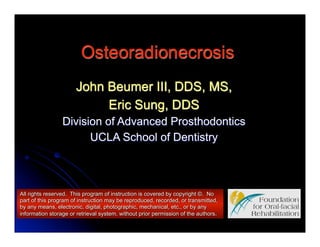Osteoradionecrosis is bone necrosis that occurs in the radiation treatment volume months after treatment. It is caused by loss of vasculature due to radiation damage. Risk factors include radiation dose over 6500 cGy, chemotherapy, brachytherapy, and post-radiation dental extractions. Advanced cases can lead to fistulas, fractures, and discontinuity defects impacting functions like speech and swallowing.




































































































